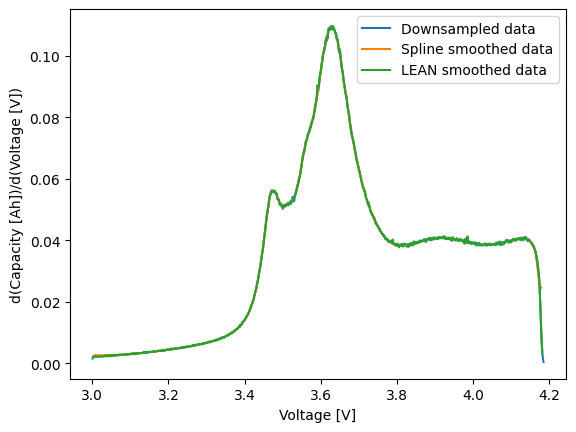Differentiating voltage data#
Differential Voltage Analysis (DVA) and Incremental Capacity Analysis are popular methods of characterising the degradation state of a cell. PyProBE offers multiple methods to the user which will be explored in this example.
First import the package and dataset:
[1]:
%%capture
%pip install matplotlib
[2]:
import matplotlib.pyplot as plt
import pyprobe
%matplotlib inline
[3]:
info_dictionary = {
"Name": "Sample cell",
"Chemistry": "NMC622",
"Nominal Capacity [Ah]": 0.04,
"Cycler number": 1,
"Channel number": 1,
}
data_directory = "../../../tests/sample_data/neware"
# Create a cell object
cell = pyprobe.Cell(info=info_dictionary)
cell.add_procedure(
procedure_name="Sample",
folder_path=data_directory,
filename="sample_data_neware.parquet",
)
The break-in cycles of this dataset are at C/10, so can be analysed as pseudo-OCV curves. We’re going to look at the last cycle:
[4]:
final_cycle = cell.procedure["Sample"].experiment("Break-in Cycles").cycle(-1)
final_cycle.discharge(0).plot(x="Time [hr]", y="Voltage [V]")
[4]:
<Axes: xlabel='Time [hr]'>
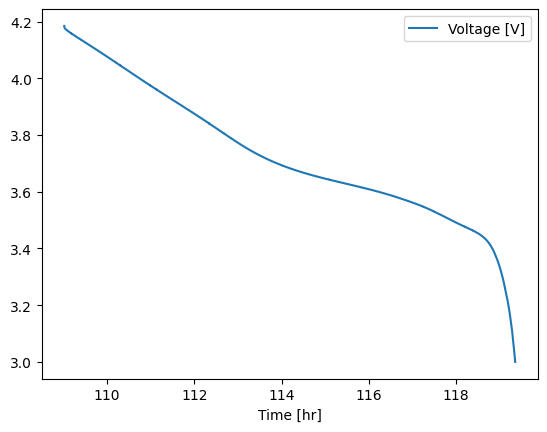
We’re going to look at using the finite-difference based differentiation method, first on the raw data:
[5]:
from pyprobe.analysis import differentiation
raw_data_dVdQ = differentiation.gradient(
final_cycle.discharge(0), "Capacity [Ah]", "Voltage [V]"
)
print(raw_data_dVdQ.column_list)
raw_data_dVdQ.plot(x="Capacity [Ah]", y="d(Voltage [V])/d(Capacity [Ah])")
['Capacity [Ah]', 'Voltage [V]', 'd(Voltage [V])/d(Capacity [Ah])']
[5]:
<Axes: xlabel='Capacity [Ah]'>

This gives a clearly poor result. This is due to the noise in the experimental data. We can apply a smoothing function to the voltage prior to differentiating to remove this noise:
[6]:
from pyprobe.analysis import smoothing
downsampled_data = smoothing.downsample(
input_data=final_cycle.discharge(0),
target_column="Voltage [V]",
sampling_interval=0.002,
)
fig, ax = plt.subplots()
final_cycle.discharge(0).plot(
x="Capacity [Ah]", y="Voltage [V]", ax=ax, label="Raw data"
)
downsampled_data.plot(
x="Capacity [Ah]", y="Voltage [V]", ax=ax, style="--", label="Downsampled data"
)
[6]:
<Axes: xlabel='Capacity [Ah]'>
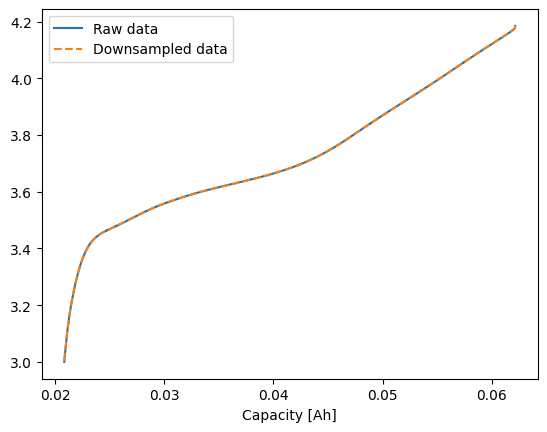
We can now differentiate the smoothed data object:
[7]:
downsampled_data_dVdQ = differentiation.gradient(
downsampled_data, "Voltage [V]", "Capacity [Ah]"
)
fig, ax = plt.subplots()
downsampled_data_dVdQ.plot(
x="Voltage [V]",
y="d(Capacity [Ah])/d(Voltage [V])",
ax=ax,
label="Downsampled data",
)
ax.set_ylabel("d(Capacity [Ah])/d(Voltage [V])")
[7]:
Text(0, 0.5, 'd(Capacity [Ah])/d(Voltage [V])')
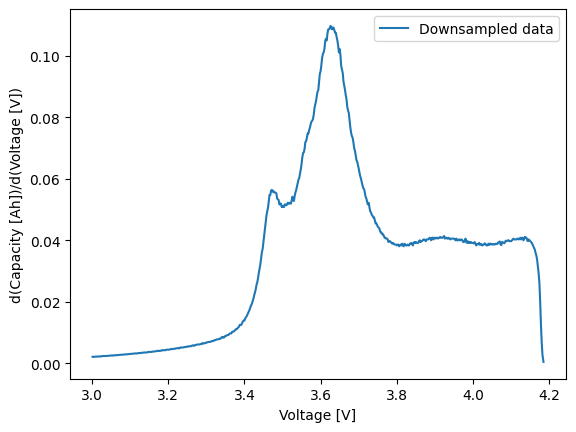
PyProBE has multiple smoothing methods, so you can easily compare their effect on the ICA result:
[8]:
spline_smoothed_data = smoothing.spline_smoothing(
input_data=final_cycle.discharge(0),
x="Capacity [Ah]",
target_column="Voltage [V]",
smoothing_lambda=1e-10,
)
spline_smoothed_data_dVdQ = differentiation.gradient(
spline_smoothed_data, "Voltage [V]", "Capacity [Ah]"
)
fig, ax = plt.subplots()
downsampled_data_dVdQ.plot(
x="Voltage [V]",
y="d(Capacity [Ah])/d(Voltage [V])",
ax=ax,
label="Downsampled data",
)
spline_smoothed_data_dVdQ.plot(
x="Voltage [V]",
y="d(Capacity [Ah])/d(Voltage [V])",
ax=ax,
label="Spline smoothed data",
)
ax.set_ylabel("d(Capacity [Ah])/d(Voltage [V])")
[8]:
Text(0, 0.5, 'd(Capacity [Ah])/d(Voltage [V])')
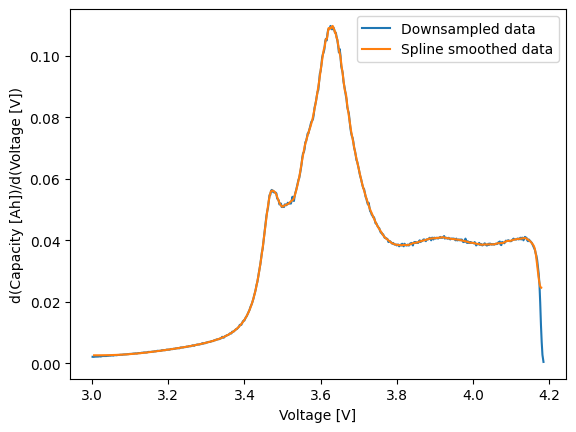
We can also compare to an alternative differentiation method, the LEAN method described in Feng X, Merla Y, Weng C, Ouyang M, He X, Liaw BY, et al. A reliable approach of differentiating discrete sampled-data for battery diagnosis. eTransportation. 2020;3: 100051. https://doi.org/10.1016/j.etran.2020.100051.
[9]:
LEAN_dQdV = differentiation.differentiate_LEAN(
input_data=final_cycle.discharge(0),
x="Capacity [Ah]",
y="Voltage [V]",
k=10,
gradient="dxdy",
)
fig, ax = plt.subplots()
downsampled_data_dVdQ.plot(
x="Voltage [V]",
y="d(Capacity [Ah])/d(Voltage [V])",
ax=ax,
label="Downsampled data",
)
spline_smoothed_data_dVdQ.plot(
x="Voltage [V]",
y="d(Capacity [Ah])/d(Voltage [V])",
ax=ax,
label="Spline smoothed data",
)
LEAN_dQdV.plot(
x="Voltage [V]",
y="d(Capacity [Ah])/d(Voltage [V])",
ax=ax,
label="LEAN smoothed data",
)
ax.set_ylabel("d(Capacity [Ah])/d(Voltage [V])")
[9]:
Text(0, 0.5, 'd(Capacity [Ah])/d(Voltage [V])')
